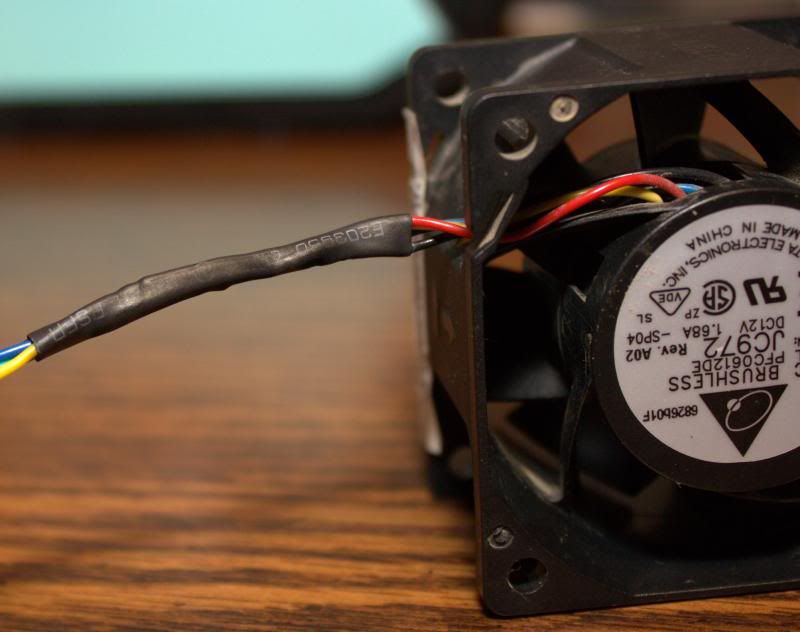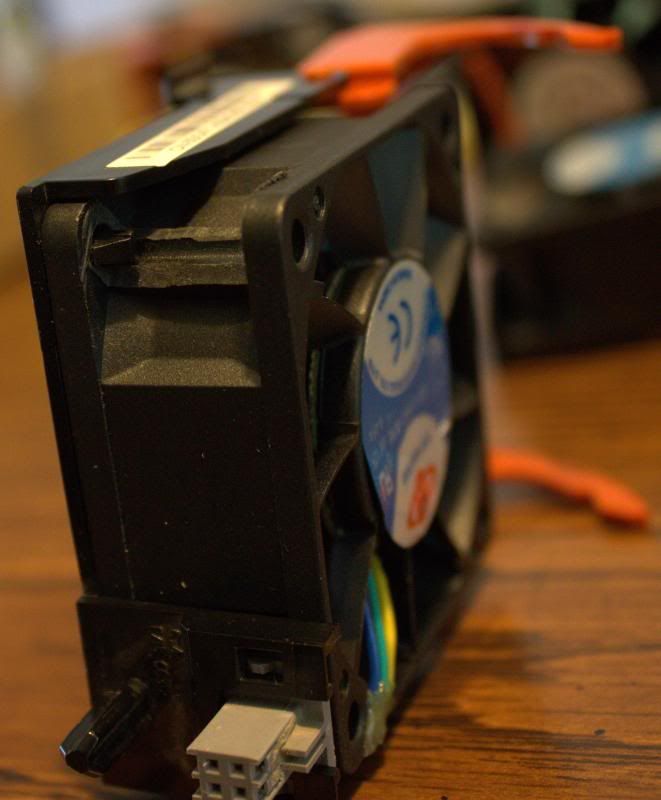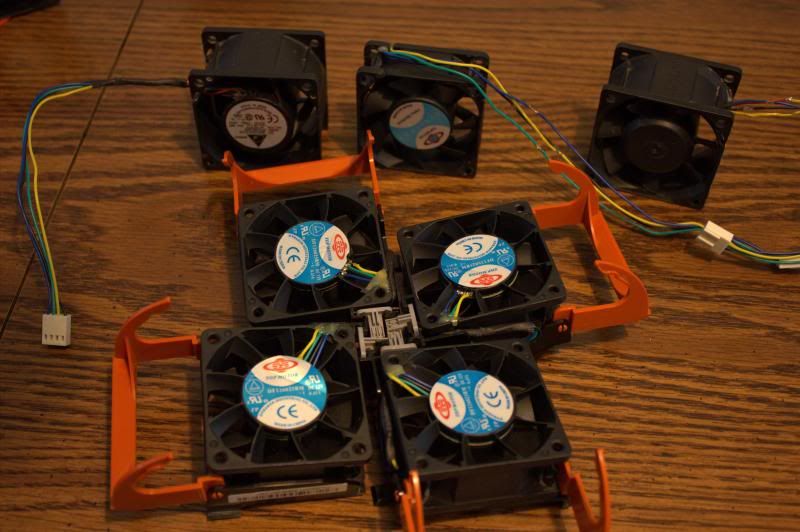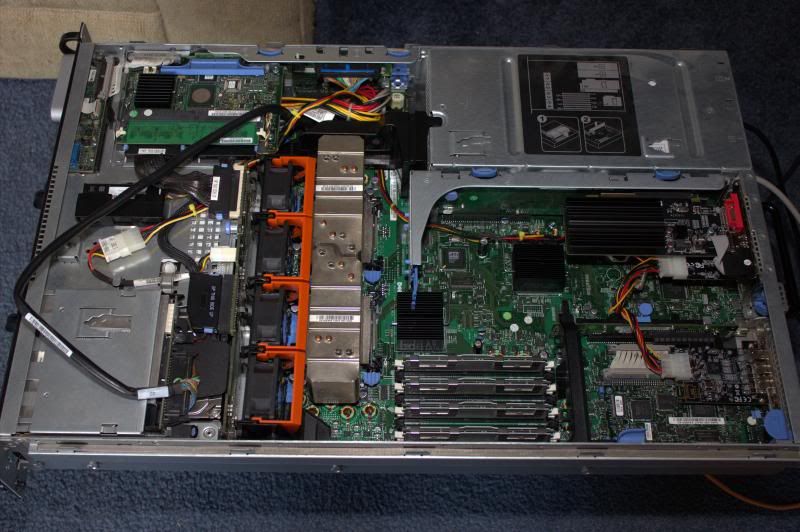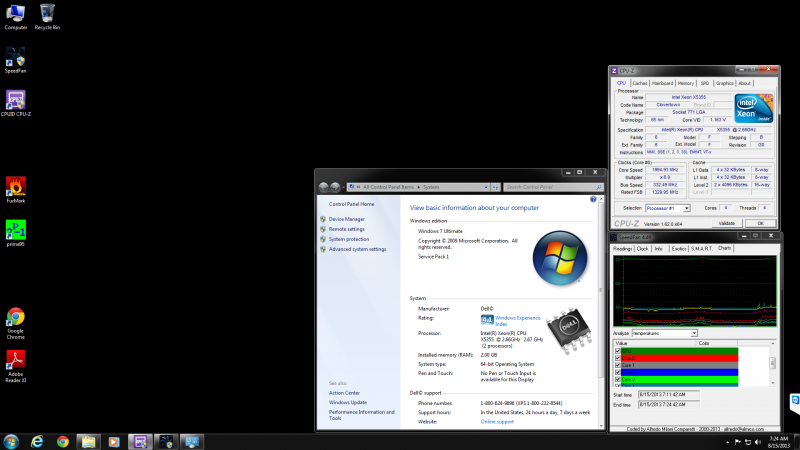Friday, August 23, 2013
Labels:
Dell
,
noise reduction
,
PowerEdge 2950
Dell PowerEdge 2950: Silence the Noise, Kevin's Chassis Fan Fix
This post relates the tale of our brother-in-arms Kevin, who valiantly pursued the quest to silence the PowerEdge 2950 with dogged determination. The focus here is on the chassis fans. I'll post another entry regarding his efforts to swap out the power supply fans and hack the BMI. And now, to the fixes.
Read More
Step 1: Update the BMC firmware
After updating the Baseboard Management Controller firmware, the fan speed slopes changed. The fans now have a lower minimum speed and are noticeably quieter. Dell Poweredge 2950 BMC firmware update v.2.50, A00
Step 2: Replacement fans
I selected the Top Motor FA60TM3BMP as a replacement, since the FA60TM3BEP isn't carried any more by BestByte.com. A representative at BestByte named Barry was very helpful in referencing the spec sheet for top motor fans they did carry.
The Top Motors seem to be just a re-brand of Dynatron parts. According to the spec sheet the Top Motor FA60TM3BMP corresponds to the Dynatron DF126025_M. With 7000RPM, 38.28cfm, 48.1 DBA, and 13.55 mm/H2O of static pressure, these fans should give an acceptable margin for error.
Now for the frustrating parts. All the replacement fans needed to have their connectors swapped with the stock fans, as well as having the closed mounting holes opened up. A simple re-pin didn't work because the pins are not compatible for a simple swap. Specifically, the Top Motor pins were too large for the stock fan connector.
The solution:
Also of note is that the power supplies had the same high speed fans as the stock cpu coolers. Solder swapping the connectors for those as well with two more Top Motors resulted in the server failing to get past the first POST screen when the power supply fans are at too low of an RPM. For the time being, the stock PSU fans were reinstalled, but the planned solution is to hack the BMC.
- Simply cut the wires:
- Swap the connector leads, solder the wires back together, and apply some heat shrink tubing:
Voila! Some Top Motor fans with proper connectors. - Used a hacksaw, long handled pliers, and a Dremel cutting wheel to open up the closed mounting holes:
- Modified fans in cages:
- Modified fans installed:
- Results:
Poweredge 2950 at idle with modified fans
Poweredge 2950 at full load with modified fans
Some users on the Hacking guide thread have commented that the BMC hacking guide works on the 2900 as well as the 2800, and by extension the 2950.
One more thing. Unrelated but someone may find it useful. I was able to replace a 2950 Gen I motherboard for a 2950 Gen II motherboard and everything worked just fine. No weird boot up issues or anything. With the Gen II motherboard I now have quad core cpu capability, and I was able to install those nice quad cores without issue.
Friday, August 16, 2013
Labels:
Altamira
,
CTF
Last weekend, I participated in the first annual Altamira CTF competition, and I'm posting a review of my experience for those that would like to know what it was like and for those that may be interested in attending next year. The general overview of the game can be found on Altamira's Game Information Page, but the synopsis can be parsed down to three core objectives:
Offense
Altamira CTF 2013: Lessons Learned
Last weekend, I participated in the first annual Altamira CTF competition, and I'm posting a review of my experience for those that would like to know what it was like and for those that may be interested in attending next year. The general overview of the game can be found on Altamira's Game Information Page, but the synopsis can be parsed down to three core objectives:
- Defend a nuclear reactor from attack as well as maintain services and generate energy
- Actively exploit and attack opponents to obtain flags
- Scan network and identify hidden assets and obtain flags
Before the game began, we were provided with the rules of the game along with our internal/external IP space. Each team had a similar set up.
Tools
All team members used Kali 1.0.4 as their operating system of choice
for game play. Tools within Kali used in
the game included: metasploit 4.7.0 with postgres 9.1, armitage, nessus 5.0.3,
and ufw/gufw.
Special note. If using metasploit 4.7.0 as your framework, you must use Nessus 5.0.3 if you want to load the Nessus plug-in. Visiting Tenable's download page only leads you to links for 5.2.x. Here are a couple shortcuts to 5.0.3 to save you time from analyzing their site code and finding the package names:
Sharing
the Database
Prior to the competition, the team agreed that to eliminate duplication
of effort, we needed to use a shared database for offensive
purposes. At the same time, the shared
database needed to be protected. We set
up the postgres database, nessus, and an armitage team server instance to all
be accessible remotely. To protect the
centralized infrastructure, we leveraged ufw/gufw, which works great since it starts out with a default deny for incoming traffic. When the competition started, team members quickly fed me their IP addresses, and I loaded the rules into gufw. I'll be posting a separate guide on how to share out the database, which is simple once you've done it a couple times.
Defense
Once the game began, offense provided the defense the results of
scanning the team Scram server with the identified ports (80, 22). Accessing the team server via HTTP on port 80
showed us the web page where the actual Scram game was running:
Check out the video above for the full briefing, or click here to jump to what our interface looked like.
After logging in to the server via SSH, the
root password was changed. With the
password changed, the defenders set about learning how to play the Scram game
since megawatts per hour (MwH) was a scored component.
Discoveries
We learned about halfway through the game that another team analyzed their team
server's game code and found a way to accelerate their point gain. We did not dedicate enough resources to
emulating this approach until the last hour of the game (fail!).
The Scrame game itself was built in python and had multiple
components. There was an environment.py
script which contained variables and formulas in which the score was
calculated. In another directory was a
network.py script which took the results and sent them to the scorebot. The packet was ultimately crafted using scapy
in another python script. The service
for these python scripts was something called "twisted" that utilized
websocket initialization scripts, also written in python. A danger in altering the game code was that
depending on the alteration, teams would need to restart the service components
and do so in the right order. Failure to do so would result in a loss of
accumulation of points. Note to self, learn things...
Offense
As soon as the team was wired in, offense scanned both the
internal network and the external network to identify hosts. The scan was run
using Armitage, and because we didn't know of any hosts, we included the whole
ranges. Results populated
"live" hosts and "ghost" hosts. Scanning a "ghost" host resulted in
no open ports. Not having read
Armitage's documentation, Armitage may automatically place an entry for each
host in the range through its scanning script.
For cleaning our visual display, we set the view to table view and
removed "ghost" hosts. Note to self, learn to avoid this in the future.
With the remaining live targets, we ran multiple port scans
and nessus scans against them. We were
able to get shells on two or three linux machines. All Windows machines were running Windows 7. More on that in the next paragraph.
Discoveries
From one of the shells, there was limited command line
access. Commands like "ls"
worked, but "cd" and pretty much anything else did not. We did not attempt to load another shell (fail!).
Several of the Windows machines were Windows 7 Service Pack
1, build 7601. The default install of
Metasploit 4.7.0 does not have any exploits for that build. MS_09_50 did not work. Enumerating these machines using the endpoint
mapper auxiliary module revealed 6 to 7 machines were part of the same domain
(PONY_GROUP), while 3 to 4 were part of another domain (NOVAC). Had we gained access to one Windows 7 machine
in either domain, we could've used pass the hash to get access to the others. Shoulda, coulda, woulda...
Lessons Learned
- CTFs in this format are "unknowns", meaning be prepared the best you can and expect something new and different
- In CTFs where hacking the game mechanism itself is allowed, resources should be devoted to analyzing the game code at the start
- Where CTFs provide information about the infrastructure, such as in this case the game Scram, study and any all related resources prior to the start of the competition
- Have a tool such as WinSCP or know how to secure copy in Linux to copy files and folders from an SSH session
- Identify all known metasploit modules/exploits built by others for use against Windows 7 and test usage
Additional Information
Wednesday, August 14, 2013
Labels:
Cyber (InfoSec) Competitions
,
cyber challenges
,
USCC
Read More
U.S. Cyber Challenge 2013
In June I attended the U.S. Cyber Challenge, and for those that don't know about it, I'm posting a review because this is one event that deserves more attention.
To sum up what it is, here's an excerpt from the main website:
USCC Summer Camps feature one week of specialized cyber security training that includes workshops, a job fair, and a culminating “Capture the Flag” competition. The workshops are lead by college faculty, top SANS Institute instructors, and cyber security experts from the community. The workshops and presentations focus on a variety of topics ranging from intrusion detection, penetration testing and forensics. Participants can also participate in a job fair that provides them the opportunity to meet with USCC sponsors and discuss potential employment. The week-long program ends with a competitive “Capture the Flag” competition and an awards ceremony attended by notables in the cyber security industry and government.
Qualifying
 |
| Image Credit: vmpyrdavid |
In order to attend the camp, you have to compete in the initial challenge. This year that involved packet capture analysis, which tested not only your ability to filter through the pcap for relevant information, but also to identify in the pcap what type of web-based attack was happening (XSS, SQLi, etc). Based on how well you performed, you are sent an invitation email. I think the invitation is really just a process to weed out those individuals that are really motivated or genuine about attending the event, because to complete the invitation, you have to seek out two letters of recommendation (LoR). One of those letters can be personal from a friend, but the other has to be from either a teacher or your boss. People not willing to go to those lengths are not given further consideration.
After submitting the LoR, I received an email confirming my selection along with instructions for attendance!
Event Venue
Apparently, the event venue changes from year to year and in 2013 it was held at the Hotel Roanoke in Virginia. USCC attendees were slated two to a room. Make sure you check out the event logistics for future years so you don't mistakenly tell someone they can come room with you and then have to nix those plans later.
The hotel had all the required amenities including a gym, pool, and cafe/bar. Hotel wireless is bound to the credentials of the person checking in, and there's a max of 5 devices per login.
Attached to the hotel was a conference area where the USCC conference would be held. The wireless signal reached in all areas, but perhaps due to the number of attendees, bandwidth was slow. Don't plan to rely on your carrier's hotspot because multiple attendees from multiple carriers had spotty service in the conference area. Your mileage may vary.
The Classes
The cyber camp is really a 4-day session of differing topics each day, capped off with a capture the flag competition at the end of the week. These were the daily sessions:
- Day 1 - Scapy
- Day 2 - Android Pen Testing
- Day 3 - Memory Forensics with Redline and Volatility
- Day 4 - Tactical Incident Handling & Hacking Techniques
Each session included SANS excerpts from their classes focusing on these topics, along with instructors who teach those classes. The quality of instruction was extremely high, and for that alone the USCC is worth attending.
At the end of day 2 there was an ethics discussion panel to review topics such as expectation of privacy. Each table was grouped into a team for discussion to review a couple hypothetical scenarios, with the results shared in an open dialog. It was very interesting conversation.
At the end of day 4 there was a job fair. Already gainfully employed, I did not attend.
Capture the Flag
Day 5 culminated into a CTF, with attendees grouped randomly into teams of four or five. The infrastructure for the CTF was provided by iSight through their Threatspace CTF platform. The challenges, from what I can remember now, were largely based on web-oriented and forensics-oriented approaches. I used OWASP-ZAP and HTTP Header manipulation tools to identify some flags from the web-based challenges. For the forensics-focused we used Wireshark, John the Ripper, Cain & Abel, and aircrack.
Although my team did not win or place, it was fun learning new tools and their extended usage.
Overall, this experience was fantastic, and I highly recommend everyone give themselves the opportunity to experience it. Keep checking the USCC Cyber Quest site for future challenges!
Subscribe to:
Posts
(
Atom
)

